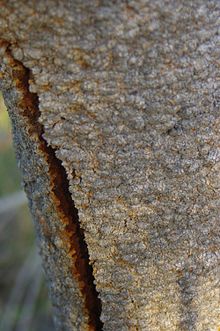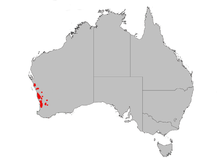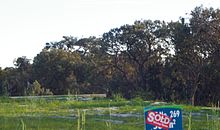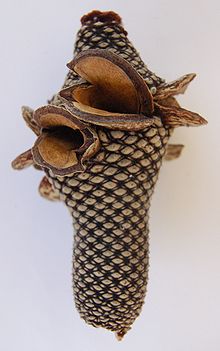- Banksia menziesii
-
Firewood banksia 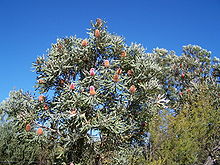
Tree habit, Jandakot Botanical Gardens Scientific classification Kingdom: Plantae (unranked): Angiosperms (unranked): Eudicots Order: Proteales Family: Proteaceae Genus: Banksia Species: B. menziesii Binomial name Banksia menziesii
R.Br.Banksia menziesii, commonly known as firewood banksia, is a species of flowering plant in the genus Banksia. It is a gnarled tree up to 10 m (35 ft) tall, or a lower spreading 1–3 m (4–10 ft) shrub in the more northern parts of its range. The serrated leaves are dull green with new growth a paler grey green. The prominent autumn and winter inflorescences are often two-coloured red or pink and yellow, and their colour has given rise to more unusual common names such as port wine banksia and strawberry banksia. Yellow blooms are rarely seen.
First described by the botanist Robert Brown in the early 19th century, no separate varieties of Banksia menziesii are recognised. It is found in Western Australia, from the Perth (32° S) region north to the Murchison River (27° S), and generally grows on sandy soils, in scrubland or low woodland. Banksia menziesii provides food for a wide array of invertebrate and vertebrate animals; birds and in particular honeyeaters are prominent visitors. A relatively hardy plant, Banksia menziesii is commonly seen in gardens, nature strips and parks in Australian urban areas with Mediterranean climates, but its sensitivity to dieback from the soil-borne water mould Phytophthora cinnamomi makes it short-lived in places with humid summers, such as Sydney. Banksia menziesii is widely used in the cut flower industry both in Australia and overseas.
Contents
Description
 Yellow and white flower colour variant, in late bud near Cataby
Yellow and white flower colour variant, in late bud near Cataby
Banksia menziesii grows either as a gnarled tree to 10 m (35 ft), or a lower spreading 1–3 metre (4–10 ft) shrub, generally encountered at its northern limits in the vicinity of Eneabba-Mount Adams; thus, it declines steadily in size as the climate becomes warmer and dryer further north.[1] In the shrub form, several stems arise from the woody base known as the lignotuber. The trunk is greyish, sometimes with shades of brown or pink, and the 2–3 cm (1 in) thick rough bark breaks away easily. The new growth is covered in fine brownish hair, which wears away after two or three years, leaving smooth stems and leaves.[2] Stems which will bear flower spikes the following year are generally thicker and longer.[3] Oblong in shape and somewhat truncate at the tips, the leaves are grey-green in colour, 8–25 cm (3–10 in) long and up to 4 cm (1.6 in) wide. The new leaves are paler and finely downy. The leaf margins are serrated with many small 1–2 mm long triangular teeth. The lower surface of the leaf has a midrib covered in fine pale brown hair.[2]
Flowering occurs in autumn and winter, peaking from May to July. Overall the inflorescences, or flower spikes, take around eight months to development from the first microscopic changes in late spring.[4] Ovoid to cylindrical in shape, the flower spikes can be up to 7–8 cm (2.6–3.4 in) wide and 4–12 cm (1.6–4.8 in) high.[2] They are composed of numerous individual flowers; one field study south of Perth recorded an average of 1043 per flower spike,[5] while another on plants in cultivation in South Australia recorded an average of 720.[6] B. menziesii has more flower colour variants than any other Banksia species, with flower spikes occurring in a wide range of pinks, as well as chocolate, bronze, yellow and white, and greenish variants. They are particularly striking closeup but can look indistinct from a distance. They are most attractive in late bud, the styles contrasting well to the body of the inflorescence, the whole looking like a red- or pink-and white vertical candy striped bloom. The inflorescences are generally a deeper red after colder weather and further into the winter.[7] Anthocyanin pigments are responsible for the red and pink shades in the flowers.[8]
Old flowers usually fall off the spikes quickly, with up to 25 large beaked follicles developing. A mottled dark brown and grey in colour, these can be prominent and quite attractively patterned when newly developed. Oval shaped, they are 2.5–3.5 cm (1–1.4 in) long by 1–1.5 cm (0.4–0.6 in) high and 1–1.5 cm (0.4–0.6 in) wide.[2] Overall, only a small fraction of flowers develop into follicles; the proportion is as low as one in a thousand.[9] The plant is dependent on fire to reproduce as the follicles only open after being burnt, each one producing one or two viable wedge-shaped (cuneate) seeds, on either side of a woody separator.[2] The colour and level of pigmentation in the seeds foreshadows the eventual colour of the inflorescences. Kevin Collins of the Banksia Farm recalled that for many years pale seeds were discarded by seed collectors who thought they were infertile. Later, he learnt that pale seeds yielded yellow-coloured blooms, dark grey the usual red-coloured, and black a distinctive bronze-coloured bloom.[10]
Seedlings have obovate cotyledons 1–1.4 cm (0.4–0.6 in) long by 1–1.5 cm (0.4–0.6 in) wide, and the leaves which develop immediately afterward are crowded and very hairy. They have serrate margins.[2] Evidence of thickening to form a future lignotuber, as well as minute buds, has been detected from the bases of seedlings at five months of age.[11]
Taxonomy
See also: Taxonomy of BanksiaThe common name of firewood banksia was a result of its quick-burning properties.[12] Other names recorded include Menzies banksia,[13] firewheel banksia, port wine banksia, flame banksia, and in the cut flower industry, strawberry banksia and raspberry frost banksia.[14] The Beeloo Whadjuk Noongar people of the Perth region knew it as the Mungyt.[15] Despite its variation across its range, George noted that B. menziesii was a clearly defined species, and no formal division into subspecies was warranted.[2]
History
Specimens of B. menziesii were first collected by the botanist Charles Fraser during Captain (later Admiral Sir) James Stirling's March 1827 exploration of the Swan River. The following year, Alexander Macleay sent some of Fraser's specimens to Robert Brown.[2] Brown formally published the species in his 1830 Supplementum Primum Prodromi Florae Novae Hollandiae,[16] giving it the specific epithet in honor of Archibald Menzies, surgeon-naturalist on the HMS Discovery under George Vancouver, who discovered King George Sound in 1791. Thus the species' full name is Banksia menziesii R.Br.[17] Neither Brown nor Menzies ever saw the plant growing.[18]
Under Brown's taxonomic arrangement, B. menziesii was placed in subgenus Banksia verae, the "True Banksias", because its inflorescence is a typical Banksia flower spike. Banksia verae was renamed Eubanksia by Stephan Endlicher in 1847,[16] and demoted to sectional rank by Carl Meissner in his 1856 classification. Meissner further divided Eubanksia into four series, with B. menziesii placed in series Salicinae.[19] When George Bentham published his 1870 arrangement in Flora Australiensis, he discarded Meissner's series, replacing them with four sections. B. menziesii was placed in Orthostylis, a somewhat heterogeneous section containing 18 species.[20] This arrangement would stand for over a century.
In 1891, German botanist Otto Kuntze challenged the generic name Banksia L.f., on the grounds that the name Banksia had previously been published in 1775 as Banksia J.R.Forst & G.Forst, referring to the genus now known as Pimelea. Kuntze proposed Sirmuellera as an alternative, republishing B. menziesii as "Sirmuellera menziesii". The challenge failed, Banksia L.f. was formally conserved, and Sirmuellera menziesii (R.Br.) Kuntze is now a nomenclatural synonym of B. menziesii.[2]
Current placement
Alex George published a new taxonomic arrangement of Banksia in his classic 1981 monograph The genus Banksia L.f. (Proteaceae).[18] Endlicher's Eubanksia became B. subg. Banksia, and was divided into three sections. B. menziesii was placed in B. sect. Banksia, and this was further divided into nine series, with B. menziesii placed in B. ser. Banksia. He thought its closest relatives to be Banksia speciosa and B. baxteri, and that it also formed a link with eastern species, particularly Banksia serrata. Since Brown's original publication had treated all of Fraser's specimens as syntypes for the species, George also chose a lectotype, selecting a tree that Fraser had received from Macleay in May 1828.[2]
In 1996, Kevin Thiele and Pauline Ladiges published a new arrangement for the genus, after cladistic analyses yielded a cladogram significantly different from George's arrangement. Thiele and Ladiges' arrangement retained B. menziesii in series Banksia, placing it in B. subser. Cratistylis along with nine other species.[21] This arrangement stood until 1999, when George effectively reverted to his 1981 arrangement in his monograph for the Flora of Australia series.[22]
Under George's taxonomic arrangement of Banksia, B. menziesii's taxonomic placement may be summarised as follows:
- Genus Banksia
- Subgenus Banksia
- Section Banksia
- Series Banksia
- B. serrata
- B. aemula
- B. ornata
- B. baxteri
- B. speciosa
- B. menziesii
- B. candolleana
- B. sceptrum
- Series Banksia
- Section Banksia
- Subgenus Banksia
B. menziesii's inflorescences resemble those of no other banksia; its closest relatives were felt by George to be B. speciosa (showy banksia) and B. baxteri (bird's nest banksia), which differs from B. menziesii in having yellow flowers and leaves with deep triangular lobes.[22] In 2002, a molecular study by Austin Mast showed its closest relatives to be the members of the series Crocinae.[23]
In 2005, Mast, Eric Jones and Shawn Havery published the results of their cladistic analyses of DNA sequence data for Banksia. They inferred a phylogeny greatly different from the accepted taxonomic arrangement, including finding Banksia to be paraphyletic with respect to Dryandra.[24] A new taxonomic arrangement was not published at the time, but early in 2007 Mast and Thiele initiated a rearrangement by transferring Dryandra to Banksia, and publishing B. subg. Spathulatae for the species having spoon-shaped cotyledons; in this way they also redefined the autonym B. subg. Banksia. They foreshadowed publishing a full arrangement once DNA sampling of Dryandra was complete. In the meantime, if Mast and Thiele's nomenclatural changes are taken as an interim arrangement, then B. menziesii is placed in B. subg. Banksia.[25]
As B. menziesii is not similar to any other Banksia, hybrids are unlikely to occur. The only reported hybrid is a sterile hybrid with B. hookeriana (Hooker's Banksia), found north of Badgingarra by Greg Keighery.[26] Manual cross-fertilisation with B. attenuata has resulted in germination, indicating that these two species are genetically compatible, but natural hybrids are extremely unlikely because the two species flower at different times.[27]
Distribution and habitat
Banksia menziesii grows primarily in deep sandy soils of the Swan Coastal Plain and Geraldton Sandplains, extending from Waroona in the south to Kalbarri in the north.[26] However, It is uncommon south of Mandurah.[28] It is generally limited to the east by the heavy soils of the Darling Scarp, but does grow on isolated patches of sand in the Jarrah Forest and Avon Wheatbelt regions, such as occur near Beverley, Toodyay and Wongan Hills. The easternmost known occurrence is a specimen collected by Roger Hnatiuk in 1979 from north-east of Brookton, about 125 km (75 mi) from the coast.[26] Much of its range on the Swan Coastal Plain coincides with Perth's expanding metropolitan area, and much habitat has been lost to clearing.[29]
Together with B. attenuata (Candlestick Banksia), B. menziesii is a dominant component in a number of widespread vegetation complexes of the Swan Coastal Plain, including B. littoralis (Swamp Banksia) or B. telmatiaea (Swamp Fox Banksia).[27] On the Geraldton Sandplains to the north, B. menziesii usually occurs as a shrub or small tree emergent above low heath.[26]
Ecology
Like many members of the family Proteaceae, Banksia menziesii is largely self-incompatible; that is, inflorescences require pollinators to be fertilised and produce seed. One mechanism by which the species promotes cross-pollination with other plants is protandry, whereby the male parts release pollen which becomes non-viable before the female parts become receptive on the same flower spike.[31] The individual flowers are uniform, and it is unclear why so few go on to develop follicles.[6] Published in 1988, a field study conducted in banksia woodland near Perth noted that anthesis occurred on an inflorescence at an average rate of 40 to 60 florets opening per day, although this varied widely between different flowerheads. Foraging by honeyeaters would cause the florets to open, but bees would not.[32]
Banksia menziesii provides an important food source, as flowers and seeds, for the threatened Short-billed Black Cockatoo (Calyptorhynchus latirostris).[33] Other bird species that have been observed feeding on B. menziesii include the Red-capped Parrot (Purpureicephalus spurius),[34] Western Rosella (Platycercus icterotis), Red-tailed Black Cockatoo (Calyptorhynchus banksii), Australian Ringneck (Barnardius zonarius), Western Gerygone (Gerygone fusca) and several honeyeater species, the New Holland Honeyeater (Phylidonyris novaehollandiae), White-cheeked Honeyeater (P. nigra), Brown Honeyeater (Lichmera indistincta), Singing Honeyeater (Lichenostomus virescens), Western Spinebill (Acanthorhynchus superciliosus), Red Wattlebird (Anthochaera carunculata) and Western Wattlebird (A. lunulata). Insects recorded include ants and bees,[26] as well as rove beetles (family Staphylinidae).[35] A field study south of Perth noted that Banksia menziesii appeared particularly popular with the Brown Honeyeater and Western Spinebill, compared with other banksias.[5]
Twenty-one species from several orders of slime molds (myxomycetes) have been isolated from the bark of Banksia menziesii. Over half (13) were from the order Stemonitales, and Echinosteliales and Liceales were also common. The abundance of the first two orders may be due to the acidity of the bark. Another order, the Physarales, was unusually rare—other studies have demonstrated that the order is typically abundant on the bark of various species of tree around the world.[36]
Banksia menziesii regenerates after bushfire by resprouting from its woody lignotuber, or from epicormic buds on the trunk.[26] It is generally only weakly serotinous in the southern part of its range, that is, it lacks a canopy seed bank as follicles on old flower spikes in the canopy release their seed after two years, but populations retain more seed as populations move north. Lower canopies and drier climates predispose to hotter fires which are more likely to kill plants and effect seed release, and thus facilitate seedling recruitment.[1]
All banksias have developed proteoid or cluster roots in response to the nutrient poor conditions of Australian soils (particularly lacking in phosphorus).[37] The plant develop masses of fine lateral roots which form a mat-like structure underneath the soil surface, and enable it to extract nutrients as efficiently possible out of the soil. A study of three co-occurring species in banksia woodland in southwestern Australia—Banksia menziesii, B. attenuata and B. ilicifolia—found that all three develop fresh roots in September after winter rainfall, and that the bacteria populations associated with the root systems of B. menziesii differ from the other two, and that they also change depending on the age of the roots.[38]
Along with Banksia attenuata, Banksia menziesii is a facultative phreatophyte. The two species are less strictly tied to the water table and hence able to grow in a wider variety of places within banksia woodland habitat around Perth than the co-occurring Banksia ilicifolia and Banksia littoralis.[39] Recent falls of the water table on the Swan Coastal Plain from use of the Gnangara Mound aquifer for Perth's water supply as well as years of below average rainfall have caused a drop in the population and vigour of Banksia menziesii since the mid-1960s.[40] A 2009 Spanish study showed Banksia menziesii seedlings to be moderately sensitive to salinity.[41] It is also sensitive to sulfur dioxide.[42] A 1994 study by Byron Lamont and colleagues from Curtin University found that Banksia menziesii plants within 50 metres (150 ft) of road verges had crowns two and a half times bigger, and set three times as many seeds as plants further away from the road, and that this was likely due to increased availability of nutrients and water from runoff.[43]
Cultivation
Banksia menziesii has several horticultural features including patterned buds and follicles, attractive pinkish new growth, and showy flowerheads.[7] A dwarf form is commonly sold in nurseries.[44] Byron Lamont has observed that dwarf plants may grow into taller single-trunked plants in cultivation.[43]
The plant is fairly easy to grow in a mediterranean climate with good drainage and a light (sandy) soil; however, with medium to high susceptibility to Phytophthora cinnamomi dieback,[45] it is unreliable in conditions which favour the growth of the soil-borne water mould, such as summer humidity or poor drainage.[7] The use of phosphite fungicides does reduce the spread of Phytophthora.[46] It generally does poorly in eastern Australia, although it is grown commercially in southeastern South Australia as a cut flower crop. It is also grown in California and Hawaii.[7]
Seeds do not require any treatment prior to planting, and take 26 to 40 days to germinate.[47] Seeds that grow into yellow-flowered plants are pale and unpigmented, while future bronze- and red-flowered plants are dark greyish and black respectively.[10] It generally takes about five to seven years to flower from seed. The plant favours sandy well-drained soils and a sunny position and can be heavily pruned if necessary, as new growth can arise from the lignotuber. Although it is readily propagated by seed,[7] experiments with in vitro propagation found Banksia menziesii to be more difficult than other species trialled.[48]
Art and culture
The nectar of Banksia menziesii was used in a drink by the Beeloo Whadjug Nyoongar, who were also called the Mungyt people. Along with beverages from other species, it was drunk at special sweet water festivals.[15] Banksia menziesii was the subject of a book by botanical artist Philippa Nikulinsky, which showed the progress of an inflorescence from bud through flowering to fruiting and seed release over 22 watercolour plates.[49] Noted wildflower artist Ellis Rowan also painted it.[50] It was one of several wildflowers depicted on a series of plates produced by the British pottery firm Wedgwood in the early 1990s.[49]
References
- ^ a b Cowling, Richard M.; Lamont, Byron B. (1985). "Variation in serotiny of three Banksia species along a climatic gradient". Australian Journal of Ecology 10 (3): 345–50. doi:10.1111/j.1442-9993.1985.tb00895.x.
- ^ a b c d e f g h i j George, Alex S. (1981). "The Genus Banksia L.f. (Proteaceae)". Nuytsia 3 (3): 239–473. ISSN 0085-4417.
- ^ Fuss, A. M.; Pattison, S. J.; Aspinall, D.; Sedgley, M. (1992). "Shoot growth in relation to cut flower production of Banksia coccinea R.Br. and B. menziesii R.Br. (Proteaceae)". Scientia Horticulturae 49 (3–4): 323–34. doi:10.1016/0304-4238(92)90168-C.
- ^ Fuss, A. M.; Sedgley, M. (1990). "Floral initiation and development in relation to the time of flowering in Banksia coccinea R.Br. and B. menziesii R.Br. (Proteaceae)". Australian Journal of Botany 38 (5): 487–500. doi:10.1071/BT9900487.
- ^ a b Whelan, Robert J.; Burbidge, Allan H. (1980). "Flowering phenology, seed set and bird pollination of five Western Australian Banksia species". Austral Ecology 5 (1): 1–7. doi:10.1111/j.1442-9993.1980.tb01225.x.
- ^ a b Clifford, S. C.; Sedgley, M. (1993). "Pistil structure of Banksia menziesii R.Br. (Proteaceae) in relation to fertility". Australian Journal of Botany 41 (4–5): 481–90. doi:10.1071/BT9930481.
- ^ a b c d e Collins, et al. pp. 266–67.
- ^ Asenstorfer, Robert E.; Morgan, Anne L.; Hayasaka, Yoji; Sedgely, Margaret; Jones, Graham P. (2003). "Purification of anthocyanins from species of Banksia and Acacia using high-voltage paper electrophoresis". Phytochemical Analysis 14 (3): 150–54. doi:10.1002/pca.696. PMID 12793461.
- ^ Young, Andrew Graham; Clarke, Geoffrey Maurice (2000). Genetics, demography and viability of fragmented populations. Cambridge University Press. p. 256. ISBN 0-521-79421-8.
- ^ a b Collins, Kevin (2004). "Seed variation in Banksia menziesii". Banksia Study Group Newsletter (ASGAP) 6 (1): 1. ISSN 1444-285X.
- ^ Mibus, Raelene; Sedgley, Margaret (2000). "Early lignotuber formation in Banksia – Investigations into the anatomy of the cotyledonary node of two Banksia (Proteaceae) species". Annals of Botany 86 (3): 575–587. doi:10.1006/anbo.2000.1219.
- ^ "Firewood Banksia". Perth Zoo website. South Perth, WA: Government of Western Australia. 28 September 2006. http://www.perthzoo.wa.gov.au/Animals--Plants/Plants/Firewood-Banksia/. Retrieved 27 April 2010.
- ^ Holliday, Ivan; Watton, Geoffrey (2008) [1977]. Banksias: A Field and Garden Guide (3rd ed.). Adelaide, South Australia: Australian Plants Society (SA Region). pp. 106–07. ISBN 0-9803013-1-1.
- ^ Brown, Steven W. (October 2007). "Cut Flower of the Month: Banksia". Super Floral Retailing magazine website. Topeka, Kansas: Florists' Review Enterprises. http://www.superfloralretailing.com/pdf/CutFlower1007.pdf. Retrieved 27 April 2010.
- ^ a b Hill, Alan L. (8–11 October 2006). "Sharing Sweet Water: Culture and the Wise Use of Perth's Wetlands". 1st Australian National Hydropolis Conference. Burswood Entertainment Complex, Perth, Western Australia: Stormwater Industry Association. http://www.hydropolis.com.au/Papers/SIA_HILLALAN.pdf. Retrieved 22 May 2010.
- ^ a b Brown, Robert (1830). Supplementum Primum Prodromi Florae Novae Hollandiae. London: Richard Taylor.
- ^ "Banksia menziesii R.Br.". Australian Plant Name Index (APNI), IBIS database. Centre for Plant Biodiversity Research, Australian Government. http://www.anbg.gov.au/cgi-bin/apni?taxon_id=54454.
- ^ a b George, Alex S. (1981). "The genus Banksia L.f. — A case history in Australian botany". History in the Service of Systematics: 53–59.
- ^ Meissner, Carl (1856). "Proteaceae". In A. P. de Candolle (in Latin). Prodromus systematis naturalis regni vegetabilis, pars decima quarta. Paris: Sumptibus Victoris Masson.
- ^ Bentham, George (1870). "Banksia". Flora Australiensis: A Description of the Plants of the Australian Territory. Volume 5: Myoporineae to Proteaceae. London: L. Reeve & Co.. pp. 541–62.
- ^ Thiele, Kevin; Ladiges, Pauline Y. (1996). "A cladistic analysis of Banksia (Proteaceae)". Australian Systematic Botany 9 (5): 661–733. doi:10.1071/SB9960661.
- ^ a b George, Alex S. (1999). "Banksia". In Wilson, Annette. Flora of Australia. Volume 17B: Proteaceae 3: Hakea to Dryandra. CSIRO Publishing / Australian Biological Resources Study. pp. 175–251. ISBN 0-643-06454-0.
- ^ Mast, Austin R.; Givnish, Thomas J. (August 2002). "Historical biogeography and the origin of stomatal distributions in Banksia and Dryandra (Proteaceae) based on their cpDNA phylogeny". American Journal of Botany 89 (8): 1311–23. doi:10.3732/ajb.89.8.1311. ISSN 0002-9122. PMID 21665734. http://www.amjbot.org/cgi/content/full/89/8/1311. Retrieved 2006-07-02.
- ^ Mast, Austin R.; Jones, Eric H.; Havery, Shawn P. (2005). "An assessment of old and new DNA sequence evidence for the paraphyly of Banksia with respect to Dryandra (Proteaceae)". Australian Systematic Botany (CSIRO Publishing / Australian Systematic Botany Society) 18 (1): 75–88. doi:10.1071/SB04015.
- ^ Mast, Austin R.; Thiele, Kevin (2007). "The transfer of Dryandra R.Br. to Banksia L.f. (Proteaceae)". Australian Systematic Botany 20: 63–71. doi:10.1071/SB06016.
- ^ a b c d e f Taylor, Anne; Hopper, Stephen (1988). The Banksia Atlas (Australian Flora and Fauna Series Number 8). Canberra: Australian Government Publishing Service. ISBN 0-644-07124-9. pp. 164–65.
- ^ a b Lewis, Jeffrey; Bell, David T. (1981). "Reproductive isolation of co-occurring Banksia species at the Yule Brook Botany Reserve, Western Australia". Australian Journal of Botany 29 (6): 665–74. doi:10.1071/BT9810665.
- ^ Seddon, George (2004). Sense of Place: A Response to an Environment: The Swan Coastal Plain, Western Australia (Facsimile ed.). Melbourne: Bloomings Books. pp. 139–40. ISBN 1-876473-53-3.
- ^ Lamont, Byron B. (1996). "Conservation biology of banksias in southwestern Australia". In S. D. Hopper, M. Harvey, J. Chappill and A. S. George (eds). Gondwanan Heritage: Past, Present and Future of the Western Australian Biota. Chipping Norton: Surrey Beatty. pp. 292–98. ISBN 0-949324-66-3.
- ^ Heddle, E. M.; Loneragan, O. W. Havel, J. J. (1980). "Vegetation of the Darling System". Atlas of Natural Resources, Darling System, Western Australia. Perth: Department of Conservation and Land Management, Government of Western Australia; distributed by Nedlands: University of Western Australia Press.
- ^ Ramsey, M. W.; Vaughton, Glenda (1991). "Self-incompatibility, protandry, pollen production and pollen longevity in Banksia menziesii". Australian Journal of Botany 39 (5): 497–504. doi:10.1071/BT9910497.
- ^ Ramsey, M. W. (1988). "Floret opening in Banksia menziesii R.Br.; the importance of nectarivorous birds". Australian Journal of Botany 36 (2): 225–32. doi:10.1071/BT9880225.
- ^ Valentine, Leonie E.; Stock, William (December, 2008). Food resources of Carnaby's Black-Cockatoo in the Gnangarra Sustainability Strategy study area (Report). Government of Western Australia, Department of Environment and Conservation: Forest Products Commission. http://portal.water.wa.gov.au/portal/page/portal/gss/Content/reports/Valentine%20and%20Stock_Food%20Resources%20for%20Carnaby's%20Black-C.pdf. Retrieved 2010-05-12.
- ^ Barker, R. D.; Vestjens, W. J. M. (1984). The Food of Australian Birds. Melbourne University Press. pp. 1:365, 2:458. ISBN 0-643-05006-X.
- ^ Ramsey, M. W. (1988). "Differences in pollinator effectiveness of birds and insects visiting Banksia menziesii (Proteaceae)". Oecologia 76: 119–24.
- ^ Jordan, C. C.; Brims, M. H.; Speijers, E. J.; Davison, E. M., C. C.; Brims, M. H.; Speijers, E. J.; Davison, E. M. (2006). "Myxomycetes on the bark of Banksia attenuata and B. menziesii (Proteaceae)". Australian Journal of Botany 54 (4): 357–65. doi:10.1071/BT05079.
- ^ Beadle, N.C. (1968). "Some aspects of the ecology and physiology of Australian xeromorphic plants". Aust. J. Sci. 30: 348–355.
- ^ Marschner, Petra; Grierson, Pauline F.; Rengel, Zed, R. H.; Drake, P. L. (2006). "Microbial community composition and functioning in the rhizosphere of three Banksia species in native woodland in Western Australia". Applied Soil Ecology 28 (3): 191–201. doi:10.1071/BT05081.
- ^ Froend, R. H.; Drake, P. L., R. H.; Drake, P. L. (2006). "Defining phreatophyte response to reduced water availability: preliminary investigations on the use of xylem cavitation vulnerability in Banksia woodland species". Australian Journal of Botany 54 (2): 173–79. doi:10.1071/BT05081.
- ^ Groom, P. K.; Froend, R. H.; Mattiske, E. M.; Gurner, R. P. (2001). "Long-term changes in vigour and distribution of Banksia and Melaleuca overstorey species on the Swan Coastal Plain". Journal of the Royal Society of Western Australia 84: 63–69.
- ^ Rodríguez-Pérez, J.A. (2009). "Effect of salinity on seedling emergence of seven Banksia species cultivated for cut flower and foliage". Journal of Plant Nutrition 32 (9): 1540–50. doi:10.1080/01904160903093844.
- ^ Emberson, Lisa; Ashmore, Mike R.; Murray, Frank (2003). Air pollution impacts on crops and forests: a global assessment. Imperial College Press. pp. 111–12. ISBN 1-86094-292-X. http://books.google.com/?id=50feldZ9DfgC&pg=PA111&dq=Banksia+menziesii&cd=79#v=onepage&q=Banksia%20menziesii. Retrieved 8 May 2010.
- ^ a b Lamont, Byron B.; Whitten, Victoria A.; Witkowski, E. T. F; Rees, Rosemarie G.; Enright, Neal J. (1994). "Regional and Local (Road Verge) Effects on Size and Fecundity in Banksia menziesii". Australian Journal of Ecology 19 (2): 197–205. doi:10.1111/j.1442-9993.1994.tb00483.x.
- ^ Walters, Brian (November 2007). "Banksia menziesii". Australian Native Plants Society (Australia). Archived from the original on May 8, 2008. http://web.archive.org/web/20080508223321/http://asgap.org.au/b-men.html. Retrieved 2 May 2010.
- ^ McCredie, T. A.; Dixon, K. W.; Sivasithamparam, K. (1985). "Variability in the resistance of Banksia L.f. species to Phytophthora cinnamomi Rands". Australian Journal of Botany 33 (6): 629–37. doi:10.1071/BT9850629.
- ^ Shearer, B. L.; Crane, C. E.; Fairman, R. G. (2004). "Phosphite reduces disease extension of a Phytophthora cinnamomi front in Banksia woodland, even after fire". Australasian Plant Pathology 33 (2): 249–254. doi:10.1071/AP04002.
- ^ Sweedman, Luke; et al. (2006). Australian seeds: a guide to their collection, identification and biology. CSIRO Publishing. p. 203. ISBN 0-643-09298-6.
- ^ Tynan, K. M.; Scott, E. S.; Sedgley, M. (2000). "Banksia propagation. In-vitro multiplication of Banksia species". Australian Plants 21 (166): 79–82.
- ^ a b Collins, et al. p. 67.
- ^ Seddon, George; Totterdell, Colin Joseph (2005). The old country: Australian landscapes, plants and people. Cambridge University Press. pp. 147. ISBN 0-521-84310-3. http://books.google.com/?id=cvxm3-7iH2oC&pg=PA147&dq=Banksia+menziesii&cd=29#v=onepage&q=Banksia%20menziesii. Retrieved 8 May 2010.
Cited text
- Collins, Kevin; Collins, Kathy; George, Alex S. (2008). Banksias. Melbourne, Victoria: Bloomings Books. ISBN 1876473686.
External links
- "Banksia menziesii R.Br.". Flora of Australia Online. Department of the Environment and Heritage, Australian Government. http://www.anbg.gov.au/abrs/online-resources/flora/stddisplay.xsql?pnid=46121.
- "Banksia menziesii R.Br.". FloraBase. Department of Environment and Conservation, Government of Western Australia. http://florabase.dec.wa.gov.au/browse/profile/1834.
- "Banksia menziesii R.Br.". Australian Plant Name Index (APNI), IBIS database. Centre for Plant Biodiversity Research, Australian Government. http://www.anbg.gov.au/cgi-bin/apni?taxon_id=54454.
Categories:- Trees of Australia
- Drought-tolerant trees
- Trees of Mediterranean climate
- Banksia taxa by scientific name
- Eudicots of Western Australia
- Ornamental trees
- Genus Banksia
Wikimedia Foundation. 2010.



